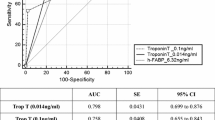Abstract
The study aimed to investigate whether heart-type fatty acid binding protein (H-FABP) measurement provides additional diagnostic value to that of conventional cardiac markers in acute myocardial infarction (AMI) within first 6 h after the onset of symptoms. The study included 120 subjects: 60 AMI cases and 60 age and sex matched controls. The cases and controls were further divided into 2 subgroups depending on the time since onset of chest pain as (1) subjects within 3 h and (2) between 3 and 6 h of onset of chest pain. In all the cases and controls, serum H-FABP concentration was measured by Immunoturbidimetric method, serum Troponin I and myoglobin concentrations by Chemiluminescence immunoassay and serum CK-MB concentration by Immuno-inhibition method. The sensitivity, specificity, positive and negative predictive values of H-FABP were significantly greater than CK-MB and myoglobin but were lesser than Troponin I in patients with suspected AMI in both within 3 h and 3–6 h groups. Receiver operating characteristic curves demonstrated greatest diagnostic ability for Troponin I (AUC = 0.99, p < 0.001) followed by H-FABP (AUC = 0.906, p < 0.001) within 3 h and 3–6 h after the onset of chest pain. In conclusion, the diagnostic value of H-FABP is greater than CK-MB and myoglobin but slightly lesser than troponin I for the early diagnosis of AMI within first 6 h of chest pain. H-FABP can be used as an additional diagnostic tool for the early diagnosis of AMI along with troponin I.


Similar content being viewed by others
References
Dienstag JL. Ischemic heart disease. In: Fauci AS, Kasper DL, Longo DL, Braunwald E, Hauser SL, Jameson JL, Loscalzo J, editors. Harrison’s principles of internal medicine, vol. 2. 17th ed. New York: McGraw Hill Medical; 2008. p. 1955–69.
Gupta R, Joshi P, Mohan V, Reddy KS, Yusuf S. Epidemiology and causation of coronary heart disease and stroke in India. Heart. 2008;94(1):16–26.
Elmadbouh I, Mahfouz R, Bayomy N, Faried W, Ghanayem N. The value of human heart-type fatty acid binding protein in diagnosis of patients with acute chest pain. Egypt Heart J. 2012;64:179–84.
McMahon CG, Lamont JV, Curtin E, McConnell RI, Crockard M, Kurth MJ, et al. Diagnostic accuracy of heart-type fatty-acid binding protein for the early diagnosis of acute myocardial infarction. Am J Emerg Med. 2012;30:267–74.
Alhadi HA, Fox KAA. Do we need additional markers of myocyte necrosis: the potential value of heart type fatty acid binding protein. Q J Med. 2004;97:187–98.
Wild D, editor. The immunoassay handbook. 2nd ed. London: Nature Publishing Group; 2001.
Bhatia DP, Carless DR, Viswanathan K, Hall AS, Barth JH. Serum 99th centile values for two heart type fatty acid binding protein assays. Ann Clin Biochem. 2009;46(6):464–7.
Kim Y, Kim H, Kim SY, Lee HK, Kwon HJ, Kim YG, et al. Automated heart-type fatty acid binding protein assay for the early diagnosis of acute myocardial infarction. Am J Clin Pathol. 2010;134:157–62.
ARCHITECT Stat Troponin: I [Package Insert]. Abbott Park, IL 60064 USA: Abbott Laboratories; 2010.
ARCHITECT Stat Myoglobin [Package Insert]. Abbott Park, IL 60064 USA: Abbott Laboratories; 2010.
Recommendations of the German Society for Clinical Chemistry. Standardization of methods for the estimation of enzyme activities in biological fluids. Standard method for the determination of creatine kinase activity (1976). J Clin Chem Clin Biochem. 1977;15:255.
Witt I, Trendelenburg C. Joint study to establish reference values for clinical chemical parameters in childhood. J Clin Chem Clin Biochem. 1982;20(4):235–42.
Pasaoglu H, Ofluoglu E, Ilhan MN, Cengel A, Ozdemir M, Durakoglugil E, et al. The role of heart-type fatty acid binding protein (H-FABP) in acute myocardial infarction compared to cardiac biochemical markers. Turk J Med Sci. 2007;37(2):61–7.
Orak M, Üstündag M, Güloglu C, Özhasenekler A, Alyan O, Kale E. The role of the heart-type fatty acid binding protein in the early diagnosis of acute coronary syndrome and its comparison with troponin I and creatine kinase-MB isoform. Am J Emerg Med. 2010;28:891–6.
Alhadi HA, Fox KAA. Heart-type fatty acid-binding protein in the early diagnosis of acute myocardial infarction: the potential for influencing patient management. Sultan Qaboos Univ Med J. 2010;10(1):41–9.
Alansari SE, Croal BL. Diagnostic value of heart fatty acid binding protein and myoglobin in patients admitted with chest pain. Ann Clin Biochem. 2004;41:391–6.
Freund Y, Chenevier-Gobeaux C, Leumani F, Claessens Y, Allo J, Doumenc B, et al. Heart-type fatty acid binding protein and the diagnosis of acute coronary syndrome in ED. Am J Emerg Med. 2012;30:1378–84.
Kim KS, Lee HJ, Kim K, Jo YH, Kim TY, Lee JH, et al. Heart-type fatty acid binding protein as an adjunct to cardiac troponin-i for the diagnosis of myocardial infarction. Korean Med Sci. 2011;26:47–52.
Acknowledgments
We would like to thank BLDE University, Vijayapur, Karnataka for the research grant towards this study. We thank the staff of the Department of Medicine and Department of Biochemistry, BLDEU’s Shri B M Patil Medical College, Hospital and Research Centre, Vijayapur for Their constant support and motivation for the collection of cases and carrying out investigations. Special thanks to Dr Kusal K Das, Professor, Department of Physiology, BLDEU’s Shri B M Patil Medical College, for valuable suggestions and inspiration. We also thank all the study subjects who took part in this study.
Funding
This study was funded by BLDE University, Vijayapur, 586103, Karnataka, India.
Author information
Authors and Affiliations
Corresponding author
Ethics declarations
Conflict of interest
Dr Anand K. Pyati, Dr Basavaraj B. Devaranavadagi, Dr Sanjeev L. Sajjannar, Dr Shashikant V. Nikam, Dr Mohd Shannawaz and Dr Satish Patil declare that they have no conflict of interest.
Ethical approval
All procedures performed in studies involving human participants were in accordance with the ethical standards of the institutional research committee and with the 1964 Helsinki declaration and its later amendments or comparable ethical standards.
Rights and permissions
About this article
Cite this article
Pyati, A.K., Devaranavadagi, B.B., Sajjannar, S.L. et al. Heart-Type Fatty Acid-Binding Protein, in Early Detection of Acute Myocardial Infarction: Comparison with CK-MB, Troponin I and Myoglobin. Ind J Clin Biochem 31, 439–445 (2016). https://doi.org/10.1007/s12291-015-0544-7
Received:
Accepted:
Published:
Issue Date:
DOI: https://doi.org/10.1007/s12291-015-0544-7




